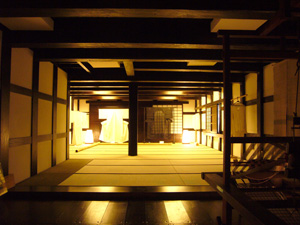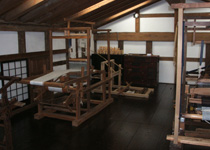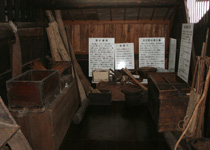
Oe Town History and Folklore Museum
The main building and storehouse of the Saito family, known as the landlord of the Jurohata in the Shichiken district since the Kanbun era, was dismantled and relocated to the side of the central public hall.Inside the museum, there are many old folk implements such as Aoso, lacquer wax, and sericulture that were popular in the past. In addition, the Doll's Festival is held at the end of March every year.
It was reopened in November 2007. In addition to the exterior, the interior, which has been noticeably deteriorated in recent years, has been completely restored, such as changing the room between boards, repairing the kitchen, and installing flush toilets. You can tour the museum, and you can also use the main building and the Japanese-style room in the storehouse. Please carry your foot in your in History and Folklore Museum.
In 2009, we started offering Aoso Gozen at the History and Folklore Museum. n addition to menus using Aoso such as Mao udon and stir-fried Aoso stems, Aoso Mochi, and Aoso jelly, you can enjoy seasonal dishes using local vegetables with lacquered furnishings that are handed down from the old family. Click here to apply 
Facility Summary
Location:〒990−1163 373-1 Hongo-cho, Oe-machi, Nishimurayama-gun, Yamagata
Bathing fees:adult100yen student50yen child30yen(There is a group discount)
Closed:2nd and 4th Tuesdays New Year holidays
Open hours:9 AM to 5
Parking Lot:56 units, 4 units exclusively for people with disabilities
Access:5 minutes by car from Aterazawa Station
Contact Us:Oe Town Education and Culture Division Tel. 0237-62-3666
Others:The Oe Town History and Folklore Museum is opened and closed at the Oe Town Central Community Center. Please drop in when you use it.
Available rooms
The Oe Town History and Folklore Museum can be used for various trainings and groups in the following rooms. The usage fee is as follows.
| section | All day | AM |
| Purlin | 1,610yen | 430yen |
| Warehouse | 1,610yen | 430yen |
| section | PM | nighttime |
| Purlin | 540yen | 640yen |
| Warehouse | 540yen | 640yen |
【時間区分】
9 AM to 12/1 PM to 5/6 PM to 10
※It will be time for preparation etc. between each time division.
【Extra charge】
・In the case of use with liquor, the amount will be double the usage fee.
・In the case of using heating, the following heating usage fee will be charged in addition to the room usage fee.
Heating fee
| section | All day | AM |
| Purlin | 330円 | 90円 |
| Warehouse | 330yen | 90yen |
| section | PM | nighttime |
| Purlin | 110円 | 130円 |
| Warehouse | 110yen | 130yen |
【About application】
Use and application will be handled by the Oe Town Board of Education.
Reservations are accepted from 3 months in advance, but may not be available due to business sponsored by the town or other reasons.
【Other】
The Oe Town History and Folklore Museum is opened and closed at the Oe Town Central Community Center. Please drop in when you use it.
In addition, due to the structure of the building, visitors may pass through and tour the room in use.
Smoking is prohibited in the entire building. It should be noted that the Central Community Center is on-site non smoking.
◆Oe Town History and Folklore Museum Experience Project
At the Oe Town History and Folklore Museum, we wanted to inherit the annual events that have been handed down from ancient times, so we adjusted to the seasons.
We are holding an event.
For event inquiries, please contact Oecho Central Community Center
〒990-1163 373-1 Hongocho, Oe Town
Oe-machi Central Community Center TEL:0237-62-3666、FAX:0237-62-3667
Description of the Site
①Saito Hansuke house
This museum was the owner before it was relocated to its current location. An old house known since the 1600s, it was located at 501 Kosei, Oe-machi. At a wholesaler called Kagaya, we handled blue-green algae, raw thread, lacquer wax, charcoal, etc., and made a big fortune by trading with Sakata and Kamigata using Mogami River shipping.
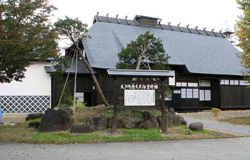
▲Exterior view of Saito Hansuke, which was relocated as a historical and folk museum
②Purlin
It is clearly stated on the building tag that it was built in 1823. The features of the structure include the seigai-zukuri, kurakake-gushi, hakama waist, the layout of the paddy-shaped deformation, and the entrance entrance, and you can feel the personality of the master.
※Segaidukuri:In order to create a deep eaves, the arms are projected from the pillars of the main building and the girders are placed on them. It is a symbol of a prestigious house with a construction method that puts a ceiling on this part.
※Hakamagoshi:Refers to the shape of the roof. A roof is hung on the gable side of the gable roof from the top of the roof to the middle like a hipped roof. The hakama waist roof is also known as "corner cut" or "half gable".
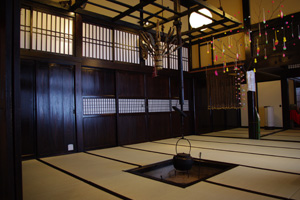
▲Purlin to Landscape
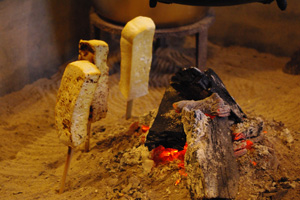
▲A soft flame in the hearth that calms the mind
③Dozo
The storehouse is a 36-two-story building (3 ken x 6 and a half ken), and is believed to be built in the Kyoho period (1716-1736), which is older than the main building. The thick chestnut pillars with a hatchet and the central pillar are particularly noticeable. It has an important meaning as a brewery of lacquer wax, which is a mountainous area.
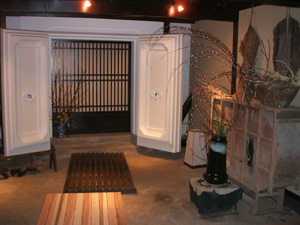
▲Dozo with a profound feeling
